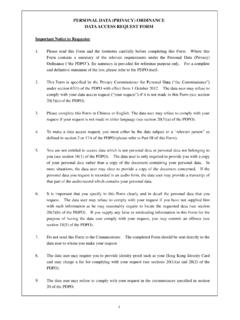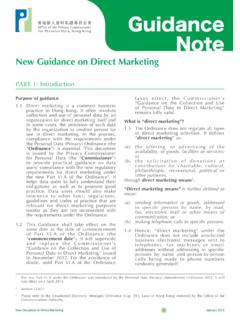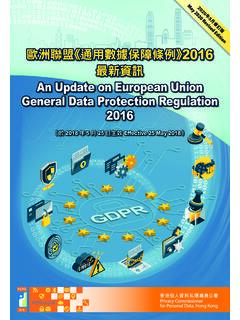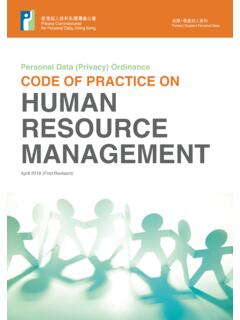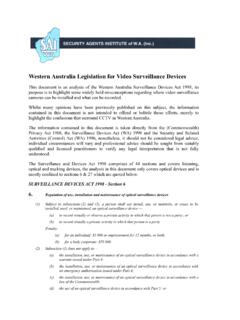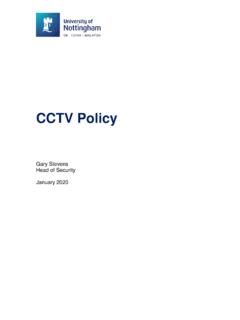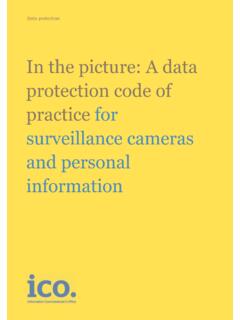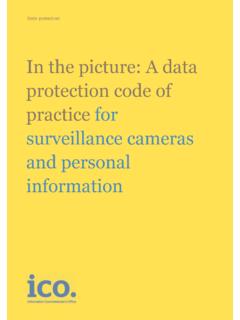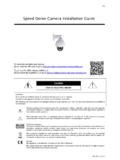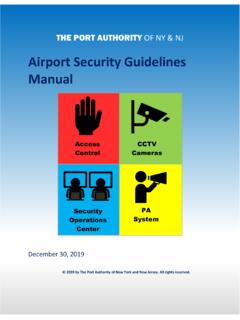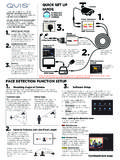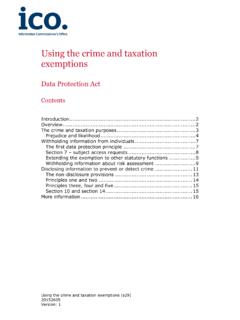Transcription of Office of the Privacy Commissioner for Personal Data
1 Guidance on cctv surveillance and Use of DronesMarch 20171 Guidance NoteGuidance on cctv surveillance and Use of DronesIntroduction_____The use of CCTV1 covering public places or common areas of buildings for security reasons or for monitoring illegal acts2 ( throwing objects from heights) has become increasingly widespread. Since cctv may capture extensive images of individuals or information relating to individuals, its use should be properly controlled to avoid intrusion into the Privacy of guidance note offers advice to data users (both organisational and individual data users) on determining whether cctv should be used in given circumstances and how to use cctv responsibly.
2 Owing to the increased popularity of unmanned aircraft systems (more commonly known as Drones ) for use in photography, surveying and surveillance , the latter part of this guidance note also provides recommendations on the use of drones from the perspective of protecting Personal data given in this guidance note are based on the key requirements under the Personal Data ( Privacy ) Ordinance (the Ordinance ) relating to the collection of Personal regards the use of cctv to monitor and record employees activities at workplaces, more specific guidance can be found in Privacy Guidelines: Monitoring and Personal Data Privacy at Work3 issued by the Privacy Commissioner for Personal Data, Hong Kong (the Commissioner ).
3 CCTV_____Privacy Impact Assessment for cctv Installation Before using cctv , data users should carry out a Privacy impact assessment, taking into account at least the following factors: Assessment Are the design and use of the cctv system appropriate, necessary and proportionate for the given circumstances? Alternatives Are there other less Privacy -intrusive means than the use of cctv to achieve the same objective? Accountability Has the data user acted and been seen to have acted responsibly and transparently, in terms of its policy, controls, and compliance with the Ordinance, in the use of cctv ?
4 cctv and the OrdinanceIf a cctv system does not have recording function (still pictures or video), its use will normally not involve collection of Personal data as defined under the Ordinance, and is therefore not regulated under the Closed Circuit Television camera surveillance systems or other similar surveillance devices that are capable of capturing images of Covert surveillance conducted by a law enforcement agency is regulated by the Interception of Communications and surveillance Ordinance, Cap Guidance on cctv surveillance and Use of DronesMarch 20172On the other hand, whether the domestic or Personal use of cctv systems covering semi-public / public areas (such as surveillance cameras installed outside a residential unit or dash cams inside vehicles) is regulated by the Ordinance would depend on whether the purpose of the installation is to collect or compile information about identified employers of domestic helpers use cctv systems to monitor their helpers, they should read Monitoring and Personal Data Privacy at Work.
5 Points to Note for Employers of Domestic Helpers4 issued by the Commissioner . Is It Necessary to Use cctv ?Data Protection Principle ( DPP ) 1(1) of the Ordinance requires that Personal data shall only be collected where it is necessary for a lawful purpose directly related to the function or activity of the data user and that the data collected shall be adequate but not assessing whether it is necessary to use cctv , the primary question to ask is Is the use of cctv in the circumstances of the case justified for the performance of the lawful function and activity of the data user and whether there are less Privacy -intrusive alternatives?
6 For example, the use of cctv for deterring and detecting specific or repeated criminal activities like the throwing of corrosive liquid from heights would appear to be justifiable. In any case, for the purpose of crime prevention, due consideration should be given to the use of less Privacy -intrusive arrangements or alternatives that could achieve the same data user should conduct an assessment objectively before installing cctv to ensure that it is the right response to tackle the problem at hand ( the throwing of objects from heights) and the degree of intrusion into Privacy is proportionate to the severity of the problem.
7 The following steps should be taken: Decide whether there is a pressing need to use cctv (for example, if the use involves public interest or public safety); Find out whether there are other less Privacy -intrusive options to better address the problem or that could be used together with cctv to make it more effective or less Privacy -intrusive; Establish the specific purpose of the use of cctv and clearly identify the problem to be addressed. For example, a bank may want to use cctv to deter thieves from robbing customers who use ATM machines to withdraw money, and the operator of a public open car park may want to use cctv to monitor the safety of users and the security of vehicles parked; Collect relevant information to see whether cctv will substantially solve the problem at hand.
8 For example, if a property management company intends to use cctv to tackle the problem of objects thrown from heights, records of similar incidents and the effectiveness of the use of cctv to successfully prevent or detect the incident would be relevant; Assess whether there is genuine need for the use of high definition equipment to record detailed facial images of individuals. For example, detailed facial images are generally not required when cctv is used for monitoring traffic flow or crowd movement; Any facial recognition system used in conjunction with cctv must be supported by strong justification as the use of cctv to enable automatic identification and tracking of individuals captured on cctv footage is not normally expected by the public; Consult, where practicable, people who may be affected by the cctv on what their concerns are, what steps may be taken to address these concerns and minimise the Privacy intrusion.
9 Covert cctv surveillance should not be used without strong / overriding justification, and only as the last resort; and Clearly determine the scope or extent of monitoring. For example, it is not appropriate to use cctv as a permanent measure when it was intended to address a temporary See Guidance on cctv surveillance and Use of DronesMarch 20173 Positioning of cctv Cameras and NoticesCCTV cameras should be positioned in a way that will not unnecessarily intrude into the Privacy of individuals. No cctv cameras should be installed in places where people have a reason to expect Privacy ( changing room).
10 cctv systems as a whole should be properly protected from vandalism or unlawful should be explicitly informed that they are subject to cctv surveillance . An effective way is to put up conspicuous notices at the entrance to the monitored area and affix further notices inside the area as reinforcement. This is particularly important where the cctv cameras themselves are very discreetly located, or located in places where people may not expect to be subject to surveillance (for example, in a taxi or a public light bus).The notices should contain details of the data user operating the cctv system, the specific purpose of surveillance and the person to whom matters relating to Personal data Privacy issues can be Handling of the Recorded ImagesDPP2(1) and DPP2(2) impose a duty on data users to ensure data accuracy and that there is no excessive retention of Personal Personal data collected should be deleted from the cctv as soon as practicable once the purpose of collection is fulfilled.


